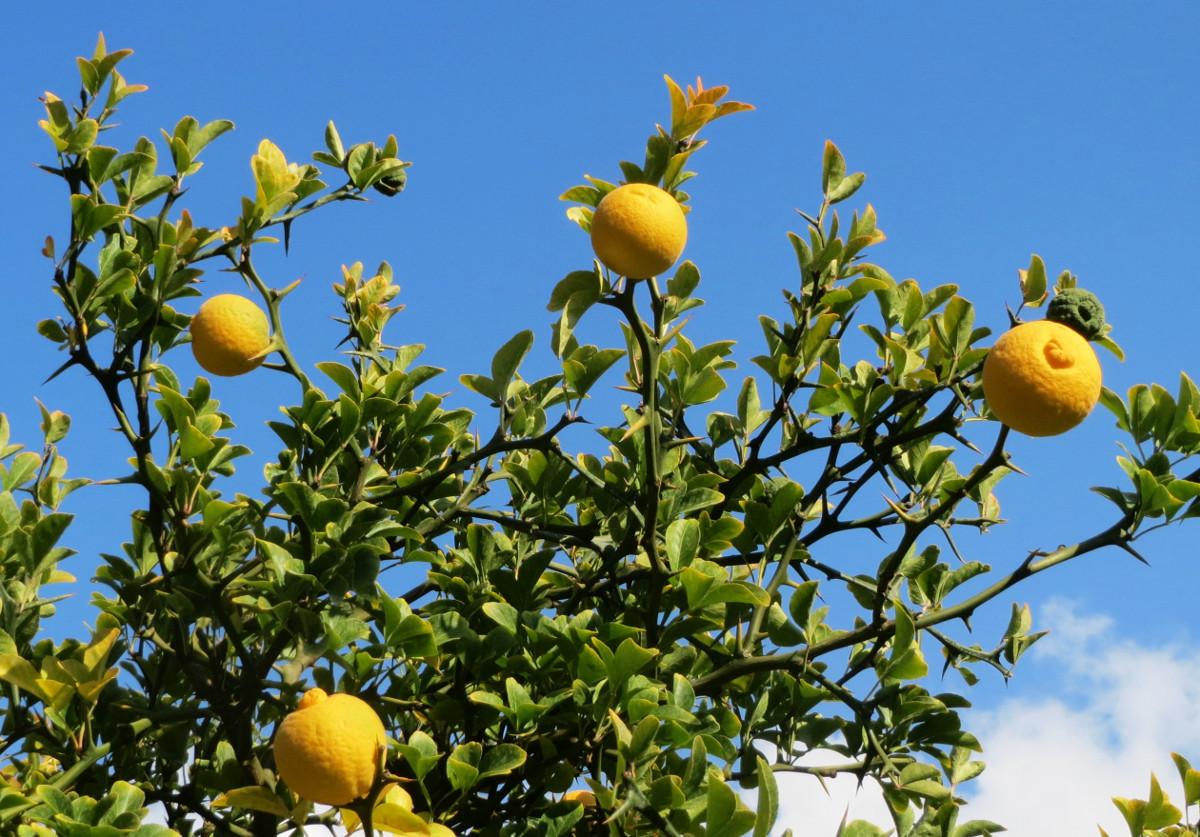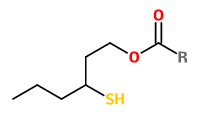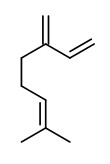Poncirus trifoliata (L.) Raf. - basionym: Citrus trifoliata L. - Rutaceae
hardy orange, Japanese bitter orange, Dreiblättrige Bitterorange, Dreiblättrige Orange
Deciduous shrub or small tree, native to China, widely cultivated in temperate regions; branches spiny, dark green; leaves three-lobed (trifoliate as per the species name); flowers fragrant, white, 4-7 petaled, 3-4cm in diameter; fruits green, ripening to yellow, and 3-5cm in diameter, resembling a small orange.
„Fruits of this citrus relative are edible (lemony flavor), but are very acidic and seedy. Fruits can used to make marmalade (use peel zest and pulp), but are usually left on the tree where they persist well into winter and often provide significant ornamental interest… A classic hedgerow plant that is virtually impenetrable due to its formidable thorns.“ missouribotanicalgarden.org
Two series of 3-sulfanylalkyl alkanoates were discovered in a peel extract of fruits of wild-growing Poncirus trifoliata (L.) Raf. (Rutaceae). The alkanoates of 3-methyl-3-mercaptobutanol and 3-mercaptohexanol are members of a family of potent odorants with tropical fruity and sulfury notes having in common a 1,3-positioned O,S moiety.
„The alkanoate residues comprise all even-numbered saturated fatty acids from C2 (acetate) to C18 (octadecanoate). Among the 20 sulfur-containing compounds identified, 14 are described for the first time as naturally occurring in a botanical species. Several cysteine-S-conjugates were synthesized as hypothetical precursors of the new volatile sulfur-containing constituents, where after S-(3-hydroxy-1,1-dimethylpropyl)-l-cysteine, S-[3-(acetyloxy)-1,1-dimethylpropyl]-l-cysteine, and S-[1-(2-hydroxyethyl)butyl]-l-cysteine were identified in the fruit peel. No cysteine-S-conjugates were detected in the fruit juice.“
[Starkenmann, Christian, Yvan Niclass, and Sina Escher. „Volatile organic sulfur-containing constituents in Poncirus trifoliata (L.) Raf.(Rutaceae).“ Journal of agricultural and food chemistry 55.11 (2007): 4511-4517]
„The oil yield of samples from var. monstrosa (3% for flavedo, 0.2% for pulp, 0.04% for seeds) growing in southern Italy (Sicily) was significantly higher than that of var. trifoliata from central Italy (Marche and Abruzzo) (1.1-1.2% for flavedo, 0.1% for pulp, 0.02-0.03% for seeds)…
The fruit flavedo was characterized mainly by monoterpene hydrocarbons (75.6-82.1%), with limonene (41.3-54.1%) and myrcene (18.2-23.2%) as the major volatile components, consistent with those of bitter orange. 32 Other compounds occurring at noteworthy levels were β-pinene (2.2-4.8%), α-phellandrene (2.7-4.7%) and (E)-β-ocimene (0.7-4.2%). The remaining flavedo oil was given mainly by oxygenated monoterpenes (3.5-6.4%), esters (0.4-5.6%) and aromatics (1.5-3.0%), with linalool (0.7-1.7%), trans-p-mentha-1(7),8-dien-2-ol (0.7-2.6%), butyl butanoate (0.7-3.4%) and p-cymene (0.7-2.9%) as the most representative… The pulp hydrodistillate showed sesquiterpene hydrocarbons (25.8-43.2%) and oxygenated monoterpenes (12.8-40.9%) as the prevalent chemical classes, with (E)-caryophyllene (22.1-33.3%) and linalool (5.8-26.5%) as the predominant volatile compounds.“
[Papa, Fabrizio, et al. „Volatile profiles of flavedo, pulp and seeds in Poncirus trifoliata fruits.“ Journal of the Science of Food and Agriculture 94.14 (2014): 2874-2887] PDF
„This fruit has such a unique aroma of strong waxy with orange-like sweetness, yuzu-like aroma, and passion fruit-like note, that its uses for fragrance applications like cosmetics could be expected… The odor-active components of the polar fraction of the peel of trifoliate orange were revealed by means of AEDA. As a result, indole, possessing a jasmine-like musty note, showed the highest FD factor of 4. Then, linalool with a floral and green note, (2E)-trans-4,5-epoxydec-2-en-1-al with a metallic and waxy note, and eugenol with a spicy note showed FD factors of 4, followed by ethyl octanoate and (2E,7Z)-trans-4,5-epoxy-2,7-decadienal with FD factors of 4. Among them, both indole and ethyl octanoate were strongly responsible for the characteristic aroma profile of the peel of trifoliate orange… Among the macrocyclic lactones having musky notes, (7Z,10Z,13Z)-hexadecatrien-16-olide showed a FD factor of 4, followed by cyclohexadecanolide and cyclohexadecen-7-olide with FD factors of 4. Hence, it was confirmed that these macrocyclic lactones contributed to the unique aroma of this fruit as well.“
[Tomiyama, Kenichi, et al. „Characteristic Volatile Components of Trifoliate Orange Peel (Poncirus trifoliata).“ Natural Product Communications 11.8 (2016): 1934578×1601100833.] PDF

Poncirus trifoliata, Ebertpark Hockenheim, Germany (PD, CC0)
wikimedia commons






